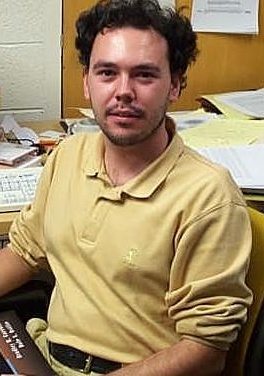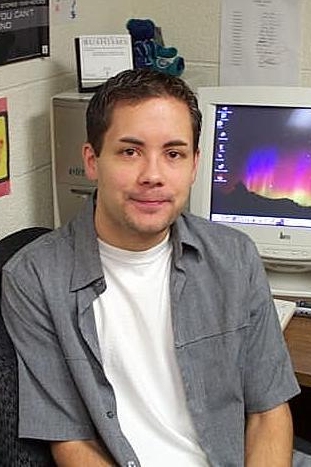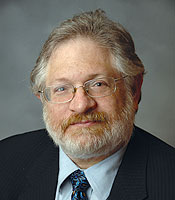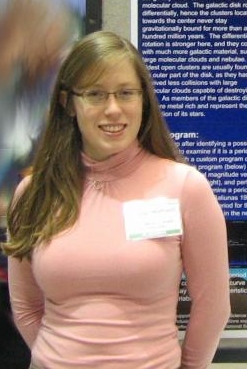The Quasar Absorption Line Group at New Mexico State UniversityPAST GRADUATE STUDENTS(click on name to jump to profile) |
Daniel Ceverino
[ Current Home Page | NMSU Dept Profile ] Ph.D. New Mexico State University (2008) B.S. University of Seville (2002) Postdoctoral Researcher, Hebrew University, Israel Born in Sevilla (Spain), Dr. Daniel Ceverino finished his PhD thesis at New Mexico State University (USA) in 2008, under the supervision of Anatoly Klypin. For his Ph.D., he refined the cosmological simulations known as "the ART code" to include the physics of stellar feedback and heating of the hydrodynamics physics. He may very well be creditied as solving the "over-cooling" problem. For his first position after graduating, Dr. Ceverino obtained a Post-Doctoral Fellow postion at the Hebrew University of Jerusalem (Israel), where hs is a member of the Cosmology Group led by Professor Avishai Dekel. Daniel recently obtained a second job in Sevilla Spain (details TBA). |
Jessica Evans
[ Current Home Page | NMSU Dept Profile ] Ph.D. New Mexico State University (2011) B.S. College of New Jersery (2002) Postdoctoral Researcher, NMSU Armed with the largest database of high resolution, high signal-to-noise quasar absorption line spectra ever compiled, Jessica undertook a Ph.D. research project (under supervision of Chris Churchill) to analyze a sample of about 490 MgII doublet systems in order to shed much needed light on our current picture of galaxy and intergalactic medium gas kinematics and structure, and to chart how these have changed throughout cosmic time. She studied the distributions of, and evolution in, the system equivalent widths, column densities, Doppler b parameters, flux decrements, and velocity widths over the redshift range 0.2 < z < 2.6 in order to construct a statistical framework for understanding the physical processes selected by the presence of MgII. She is presently deeply studying the evolution of weak MgII absorbers. |
Sarah Giandoni
[ Personal Home Page | Dept Profile ] M.S. New Mexico State University (2005) B.S. University of Wyoming (2003) Data Analyst, White Sands Missle Range For her M.S dissertation research (under supervision of Chris Churchill), Sarah studied the absorption along the quasar Q2315-771, which allowed her to study the Lyman alpha forest at low redshift, a galaxy halo at z=0.2280, and absorption in the Megallenic Strem of our Milky Way galaxy. |
Glenn Kacprzak
[ Current Home Page | NMSU Dept Profile ] Ph.D. New Mexico State University (2008) M.S. Saint Mary's University (2005) B.S. Queen's University (2001) Super Science Fellow, Swinburne University, Australia Dr. Kacprzak's Ph.D. research (under supervision of Chris Churchill) focused on understanding the formation and evolution of galaxies by studying the connection between extended halo gas and the host galaxies at both low and intermediate redshifts. He employed both observational and theoretical approaches, including use of the cosmological simulations. His sample included some forty 0.3 < z < 1.0 galaxies for which he analyzed HST images to measure morphologies, obtained emission line spectra to measure rotation curves, and measured MgII absorption in the QSO spectra. His work has been particularly acknowledged has having pushed forward the boundaries of our understanding of the connection between gas halos and their host galaxies. After graduation, he obtained a postoctoral fellowship working with Prof. Michael Murphy. He is now a Super Science Fellow in Australia. |
Brandon Lawton
[ Current Home Page | NMSU Dept Profile ] Ph.D. New Mexico State University (2008) B.S. University of Washington (2002) Office of Public Outreach, STScI Dr. Lawton did his PhD research searching (under supervision of Chris Churchill) for Diffuse Interstellar Bands (DIBs) in high redshift galaxies. He was supported by a NASA Graduate Student Research Program (GSRP) Fellowship and a NASA New Mexico Space Grant Fellowship. Though DIBs turned out very difficult to detect in damped Lyman-alpha selected galaxies, Brandon more than doubled the detection observed in the outflowing winds of starbust galaxies. Upon graduating, Dr Lawton obtained a postdoc at the Space Telescope Science Institute in Baltimore working with Dr. Karl Gordon on star forming regions in the Magellanic Clouds. They must like him there because he now has permanent employment in the STScI Office of Public Outreach as a specialist on the Virtual Astronomy Observatory (VAO), and acontributing member of the Education and Public Outreach, & NASA Science, Education, and Public Outreach Forum (SEPOF). |
Dr. Don Lubowich
[ Brief | NMSU Dept Profile ] Ph.D. New Mexico State University (2006) M.S. New Mexico State University (1977) Associate Professor, Hofstra University, New York City Dr. Lubowich studies the abundance of deuterium in the Galaxy. For his Ph.D. (under supervision of Chris Churchill), Don;s goal was to use primordial deuterium abundance to establish a method of dating objects as a function of location in the disk of the Milky Way. Using radio spectra, He measured the molecular HCN and DCN abundances in the Galactic center and at various distances out along the Galactic disk. He was able to determine that there is a deuterium abundance gradient in the Mily Way that suggestes infalling gas in the Galactic bulge has reduced deuterium abundance in that area. Upon graduating Don returned to his position at Hofstra University and was promoted to Associate Professor.
Refereed Publications on NASA/ADS
|
Allison Widhalm
[ NMSU Home Page | NMSU Dept Profile ] M.S. New Mexico State University (2009) B.S. University of Southern California (2005) Data Quality Manager, NOAO, Chile Ms. Widhalm made solid progress toward an M.S. research dissertation to study the absorption of z=0 Milky Way like galaxies in cosmological simulations. She ultimately decided to earn a "course work" Masters, passing her exams with flying colors, and then obtaining an excellent position at NOAO in Chile (exactly what she was hoping for!). Rumor has it that she may soon be attending California State University in Humboldt in an Environmental Science graduate program (details TBA). Refereed Publications on NASA/ADS |